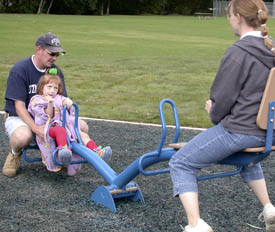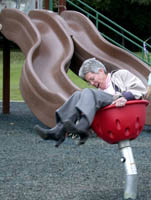More accessible playground dedicated
Elli Price’s laugh can be heard from across the playground. Her shrieks become giggles on the merry-go-round. Most of the time, her father says that she’s a happy-go-lucky 8-year-old.
However, when the world is dark, a fun toy becomes a dangerous obstacle course. Elli, who is blind, has shied away from playgrounds. Her father wanted to change that.
“Elli loves to participate in recreational activities, but it’s hard because they’re not always accessible,” her father, Rod Price, said. Price, along with Keith Christensen, has been fundraising for three years to make Angel’s Landing – a completely accessible playground for all – happen.
When counting down for the ribbon cutting, Elli grinned and her freckles bounced with her dimples. A project that started as a dream in 2001 is now finished at Willow Park West. Wheelchairs rolled across the rubber shavings, children slid down slides and spun on a merry-go-round that looks like an upside-down top.
Price and Christensen are development specialists at the Center for Persons with Disabilities on campus. The center provides mobility aids to students and members of the community in Cache Valley. Many people from the center attended Saturday.
“This is kind of a step above the requirement for disability access because it is designed for how kids play,” Nancy Yonk, CPD director said. The playground was a dedication to their children who have disabilities. Tired of watching any child being left out of anything, and used to being able to solve it at the CPD, they started fundraising. The goal was $250,000.
“We started fundraising in August 2001, and everyone knows what happened in September,” Rod Price said of the post-9/11 struggles to raise money for their project. With rising building costs and a desire to make things happen four years later, the design team scaled down the design and the project’s final cost was $220,000. The money was donated in a variety of ways including corporations, private donations and school fundraisers.
Even with downsizing, the playground can still handle family and group play. Adults jumped on the toys Saturday as much as the kids.
The Christensen family demonstrated this on the “sway fun” toy. Shawnie Christensen, who uses a wheelchair, played with her parents as they all swayed and rocked. Later, seven children shook the toy and just like the designers had hoped, disability or ability didn’t separate who was able to ride.
The playground can also work as physical therapy by aiding those with sensory, mobility and cognitive impairments. Musical instruments and spinning toys that look like upside-down tops are some of the atypical toys found.
“It’s to get that large, physical motion stimulation,” Christensen said, adding that just being at a playground helps all kids.
Others are merely adapted for everyone, no matter what they use to get around. A giant playhouse is wheelchair accessible, with wide doors and lower windows. Christensen is excited for Shawnie to be able to see the view from the top of the slide tower, too.
“It’s usually the child in the wheelchair looking up, not looking down,” he said.
-natandrews@cc.usu.edu

Designer Kieth Christensen and his daughter Shawnie, 6, play on the new equipment. (Amy Fuller)

